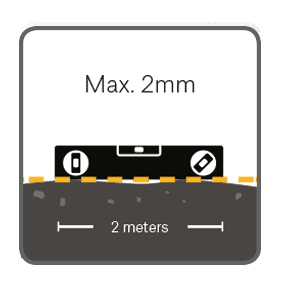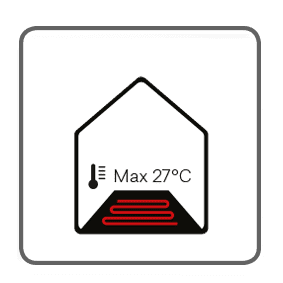Nedan är de viktigaste faktorerna för en framgångsrik montering av ett Dinesen golv.
Det är avgörande för projektets framgång att dessa faktorer beaktas innan arbetet påbörjas, då detta kommer att påverka slutresultatet.
Key Success Factors
Doors, windows etc. must be installed and the heat turned on before the installation commences.
The indoor climate must be stable and ranging from 18 - 25 °C at 35 - 65% rF, no later than the day the wood arrives, and must be maintained going forward - including when the building is in use/fully operational.
The boards may otherwise change dimension and start to cup/curve.

The delivery should always be checked for transport damages. If the delivery is damaged, please make a remark on the consignment note, and Dinesen will contact you as soon as possible.
Carry the planks inside immediately after delivery; do not leave them outside under any circumstances.
Install the planks immediately, except in winter when the planks should be placed in the room in which they are going to be installed for 24-48 hours prior to the installation.
If the floor planks are stored for a short period of time, they must be kept inside in a sealed, dry and warm room. Place the floor planks on joists and wrap them tightly in plastic – also underneath.

This is crucial as the floorboards may otherwise reflect these deviances or worse, not be properly supported.
This is particularly important for cast subfloors, as these are harder to straighten afterwards without affecting the drying time and thus time schedule.



A valid destructive concrete moisture test must be performed no later than 20 days prior to the installation. It must be destructive as surface tests are not considered sufficiently accurate.
The concrete or screed must have certain strength properties. Especially, if the floorboards are to be bonded directly to the subfloor. The requirements are - with reference to ISO17178 and EN14293 the following: CT-C30-F5.
CT: Cement based, -C30 (compressive strength: 30N/mm²), -F5 (flexural strength 5N/mm²).
Furthermore, the pull-out strength should be 1,5N/mm².
Levelling compund (generally not recommended)
Bonded floors, where a levelling compund is used, must meet the same strenght requirements as the concrete. The levelling compund must be abel to transfer the strength without loss between the two layers (typically achieved by preparing the concrete properly, e.g. with a primer - if it has dampproof capabilities, this information must be put forward, as it may affect the build-up).

If you need any additional advice, you are very welcome to our technical support.
Kenneth Windstrup Rasmussen
kwr@dinesen.com
+45 2550 5989
Underfloor heating is perfectly compatible with Dinesen floorboards, but a few things must be observed:
- It is important that the plumber pressure-tests the system to make sure there are no leaks, that the coils match the room specifications, and that the thermostats are working.
- If embedded in concrete it must have been running 30 days prior to the flooring installation to ensure all moisture has been transported from the lower part to the top part and evaporate from the surface.
- During the first week, the flow temperature must not exceed 25 °C. After the first week, it may be increased by max. 5 °C every other day, until the required surface temperature has been reached.
The surface treatment determines the look and feel of the floor as well as the maintenance required. It further determines the amount of drying time required, so it is important that this has been decided and factored into the schedule.